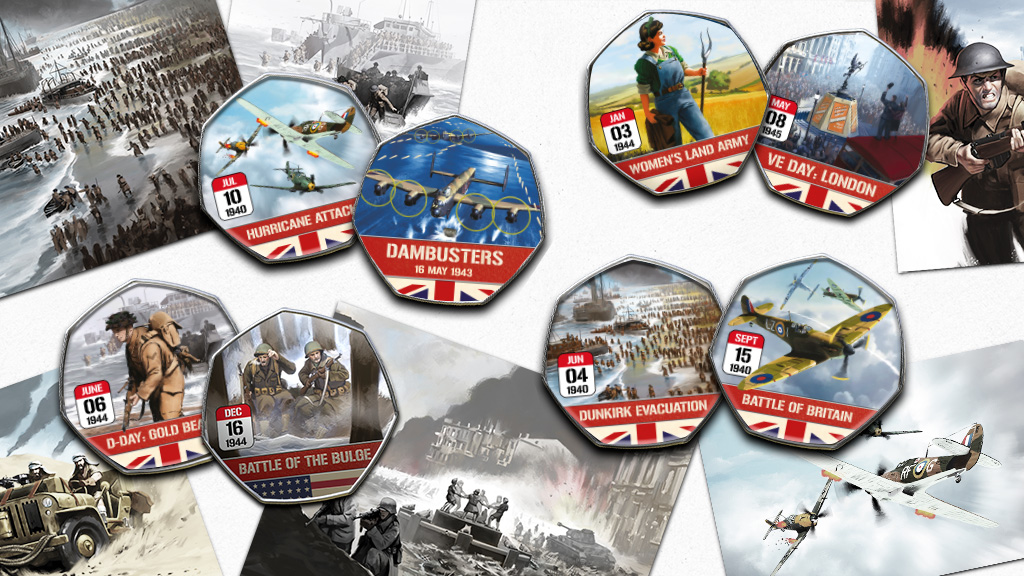Posts Tagged ‘Battle of Britain’
Commemorating Courage: The Battle of Britain Coin Range
In the summer of 1940, the skies above Britain became the front line of one of the most defining moments in modern history—the Battle of Britain. As Nazi Germany launched its relentless aerial assault, it was a group of young Royal Air Force pilots, many barely out of their teens, who stood as Britain’s last line of defence.

Against impossible odds, these brave men—later immortalised by Winston Churchill as “The Few”—repelled the Luftwaffe and changed the course of the Second World War. Their courage, determination, and sacrifice remain a source of national pride and international admiration to this day.
85 Years Later: Honouring a Nation’s Finest Hour
This year marks the 85th anniversary of the Battle of Britain. To commemorate this momentous occasion, a new range of limited edition coins has been released, celebrating both the heroism of the RAF and the historical legacy of the battle itself.
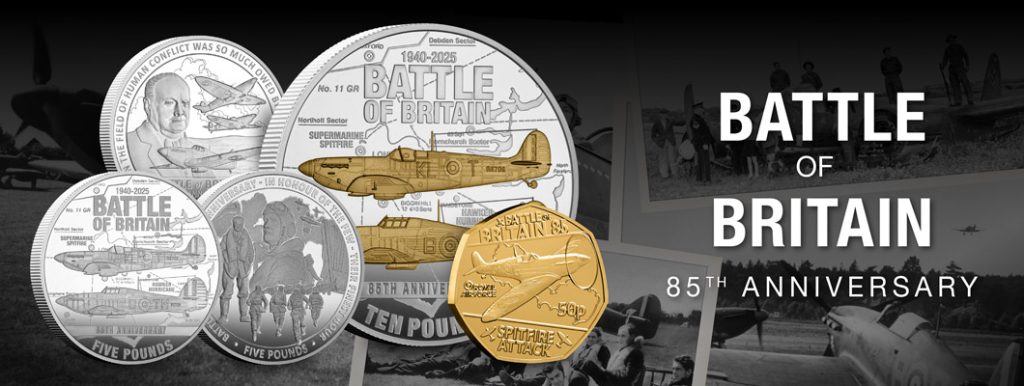
More than just currency, these coins are miniature works of art—crafted with exceptional detail, officially licensed by the RAF, and struck to the highest collector standards.
Here are three standout releases in the new commemorative range:
🔷 The Official RAF Battle of Britain 85th Silver 50p Set
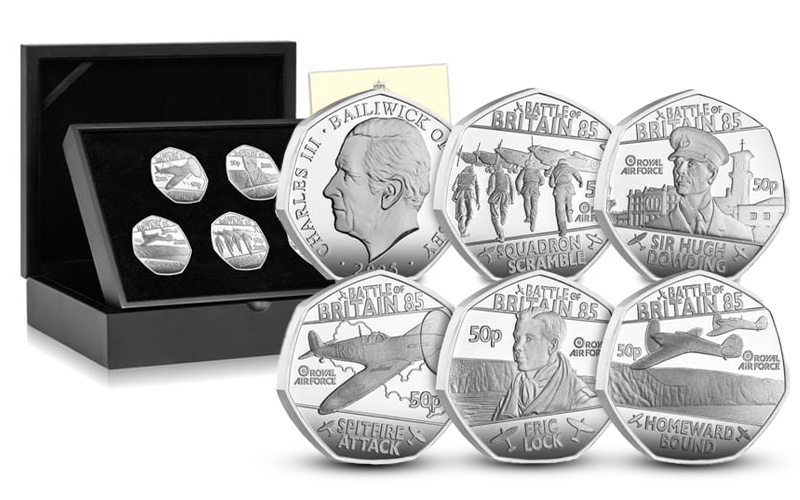
Limited to just 450 worldwide, this exclusive set includes five silver 50p coins, each one illustrating a key scene from the battle. From the iconic Spitfires soaring in formation to the resilience of those on the home front, this set offers a complete narrative in precious metal.
👉 Explore the 50p Silver Set
🔷 The Battle of Britain 85th Anniversary Silver 5oz 50p – Special Edition
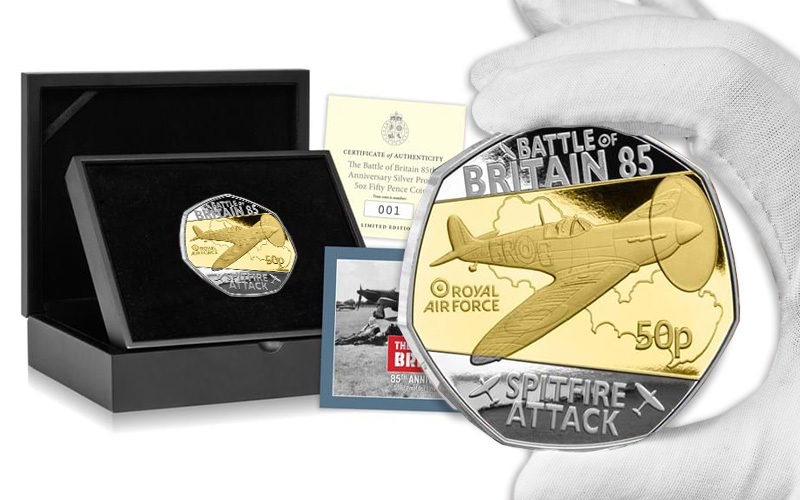
Crafted from a substantial 5oz of Pure Silver, and finished with selective 24-carat gold plating, this stunning large-format coin is limited to just 200 pieces worldwide. A commanding tribute to one of history’s greatest aerial battles.
👉 See the 5oz Special Edition
🔷 The Battle of Britain Silver Proof £5 Set
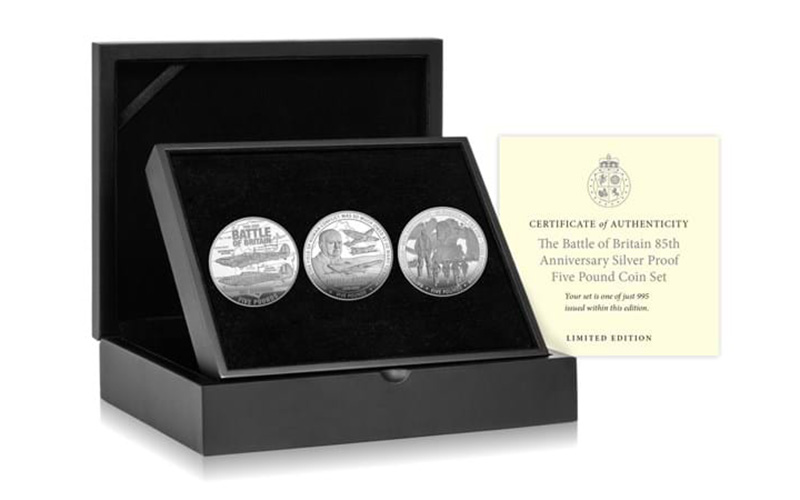
Struck in pristine silver proof quality, this set combines timeless coin artistry with a heartfelt tribute to “The Few”. It’s the perfect way to mark this historic anniversary.
👉 Discover the £5 Silver Set
Preserve History in Your Hands
Whether you’re a lifelong collector or simply someone who appreciates British history, the Battle of Britain 85th Anniversary Coin Range is a powerful way to honour the heroes of 1940. These editions are strictly limited and expected to sell out quickly.

The Spitfire: Birth of a British Aviation Icon

On March 5, 1936, the skies above Hampshire witnessed an event that would reshape the course of aviation and military history. From Eastleigh Aerodrome (now Southampton Airport), the prototype of the Supermarine Spitfire took flight for the very first time—ushering in a new era of fighter aircraft engineering. With its elegant design and formidable performance, the Spitfire would soon become a symbol of British resilience in the face of war.
The Iconic Sound
↓ Hear the iconic sound of a Spitfire fly past. Click Play Below ↓
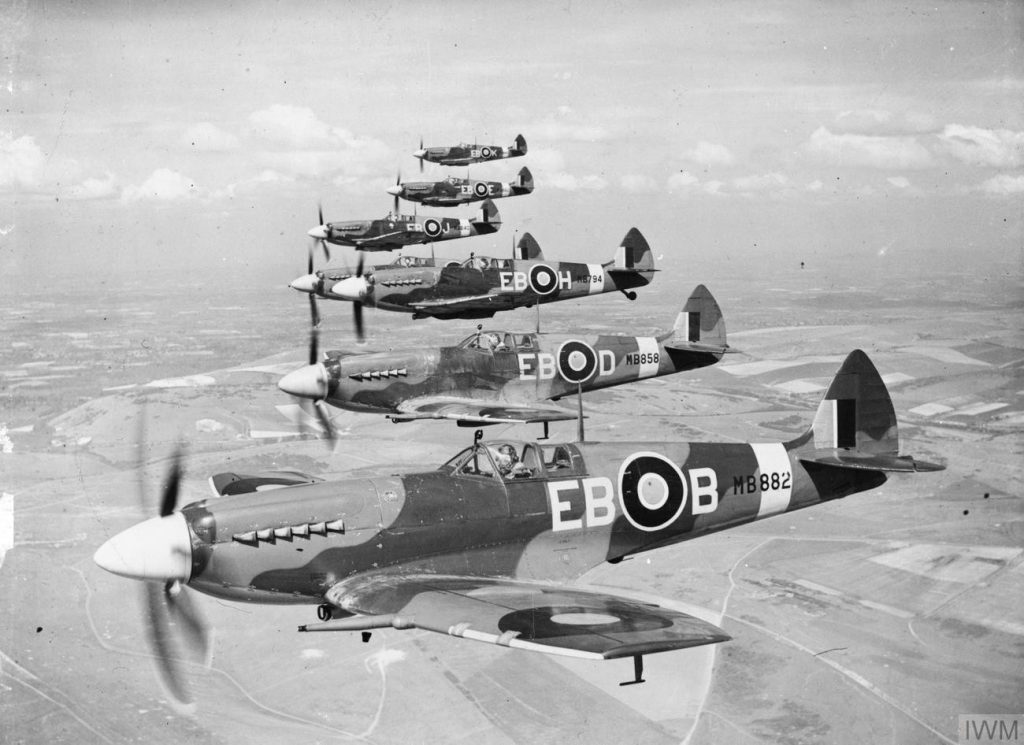
A Revolutionary Aircraft Takes Flight
The Spitfire was the masterpiece of Reginald J. Mitchell, the chief designer at Supermarine Aviation Works, part of Vickers-Armstrongs. Drawing from his experience designing high-speed racing seaplanes for the Schneider Trophy, Mitchell applied the same aerodynamic brilliance to the creation of a revolutionary monoplane fighter.
Did You Know? The Spitfire’s elliptical wing design wasn’t just stylish—it reduced drag and improved lift, giving the aircraft a tighter turning radius and better performance at high speeds than many of its contemporaries.
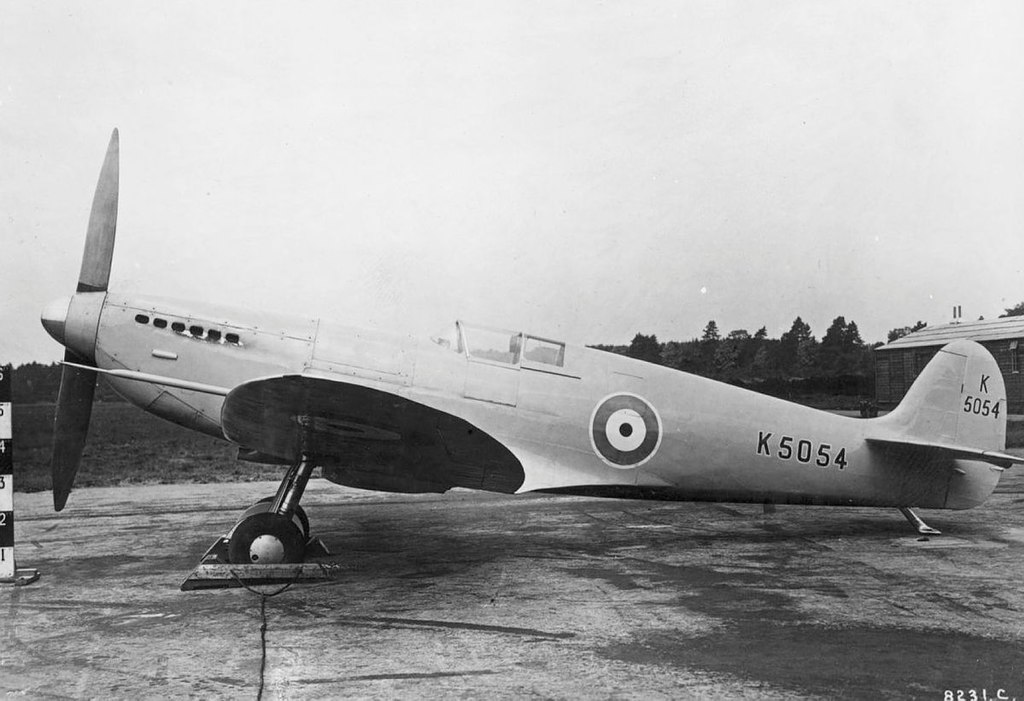
On that historic afternoon, test pilot Captain Joseph “Mutt” Summers climbed into the cockpit of prototype K5054. The aircraft, powered by the Rolls-Royce Merlin engine, performed so well during the short eight-minute maiden flight that Summers famously declared, “I don’t want anything touched!“
From Prototype to Production
The promising performance of the Spitfire’s first flight quickly caught the attention of the British Air Ministry. Just three months later, on June 3, 1936, an order for 310 Spitfires was placed, beginning what would become one of the most celebrated production runs in military aviation.
↑ Click the circles 🔴 in the image above to find out more about each part of the Spitfires Design. ↑
Did You Know? Over 20,000 Spitfires were built between 1936 and 1948, making it the most produced British fighter aircraft of World War II.
Despite early production challenges, the first units reached RAF squadrons by 1938, positioning the Spitfire as a critical asset just as tensions in Europe escalated.
Defender of Britain’s Skies
The Battle of Britain in 1940 cemented the Spitfire’s place in legend. While the Hawker Hurricane bore the brunt of the fighting, the Spitfire was instrumental in duels with the Messerschmitt Bf 109, Germany’s top-tier fighter. Its superior speed, rate of climb, and maneuverability made it a favourite among pilots and a feared opponent in the sky.
Did You Know? The Spitfire’s wings were so thin and strong that eight .303 Browning machine guns were housed within—an innovative feature at the time.
Its agility and speed became not only a tactical advantage but also a psychological one, bolstering the morale of Allied forces and the British public alike.
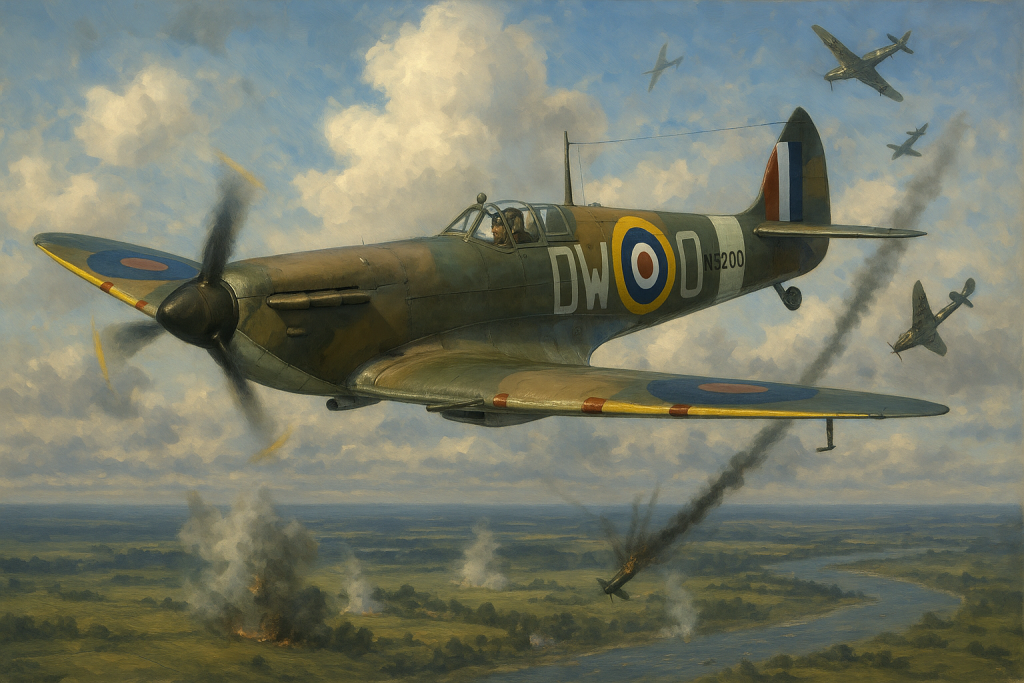
A Versatile and Evolving Design
The Spitfire was never a static design. Instead, it evolved through over 20 major variants, adapting to every phase of the war. As roles shifted, so did the aircraft: from interceptor to photo reconnaissance, from air superiority fighter to carrier-based Seafire.
Did You Know? Some Spitfires were specially equipped with cameras instead of guns and flew unarmed reconnaissance missions, providing vital intelligence over occupied Europe.
Later models even incorporated the Rolls-Royce Griffon engine, pushing the aircraft to greater altitudes and speeds.
The Legacy Lives On
Even decades after the guns fell silent, the Spitfire remains one of the most recognisable and admired aircraft in the world. Dozens of airworthy Spitfires still grace airshows and commemorative events, their distinctive Merlin engine roar still sending chills down the spine of all who hear it.

Did You Know? The name “Spitfire” was suggested by Sir Robert McLean, the then-chairman of Vickers, who reportedly described his spirited daughter as a “little spitfire.”
From wartime hero to timeless icon, the Spitfire continues to represent the innovation, courage, and determination of an era defined by conflict and triumph.
The Supermarine Spitfire’s first flight was more than a test—it was the beginning of a legend. Its combination of engineering brilliance, combat performance, and enduring symbolism has made it one of the most admired aircraft in history. From its role in defending Britain’s skies during World War II to its continued presence at airshows and in the hearts of aviation enthusiasts, the Spitfire is a testament to innovation and bravery.
Celebrate 85 Years Since the Battle of Britain

2025 marks the 85th anniversary of the Battle of Britain—a defining moment in British history where the Spitfire played a heroic role. To commemorate this significant milestone, we invite you to explore our exclusive range of Spitfire commemoratives, honouring both the aircraft and the brave pilots who flew them.
Exclusive Interview with Neil Roberts – The renowned military artist behind the NEW Britain at War Commemorative Collection
Last month, we had the privilege of diving into the creative mind of Neil Roberts, the artist behind our brand new Britain at War Commemorative Collection which encapsulates key moments from World War II.
Neil Roberts, whose work has graced the covers of Britain’s longest-running war comic book, Commando Comic, has lent his artistic prowess to craft this iconic collection.
Join us as we unravel the inspirations and creative journey that brought this remarkable project to life.
This is perhaps the most comprehensive and brilliantly illustrated WWII Collection ever created. From the Battle of Britain and D-Day, to the Great Escape, the Blitz and the Desert Rats – it’s all there.
Introducing the brilliantly illustrated WWII Collection
Special Introductory Offer – Yours FREE (+postage) when you trial the Britain at War Collection
Best of all, you can join this superb new collection for FREE (all you pay is postage). And, as a special introductory offer you will receive not one, but TWO of the commemoratives from this brilliant series for FREE (+£2.99 postage) when you trial the Britain at War Collection.
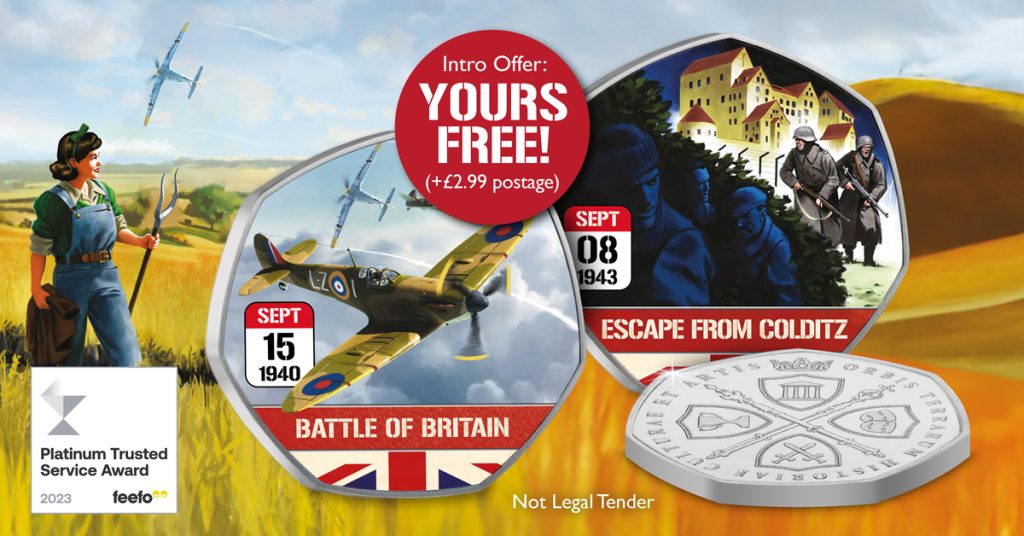
There’s nothing to lose. If it’s not for you – simply send it straight back to us and we’ll refund your postage. There’s no further commitment.
Click here to secure your FREE Battle of Britain and Escape from Colditz Commemoratives and trial the Britain at War Collection >>


